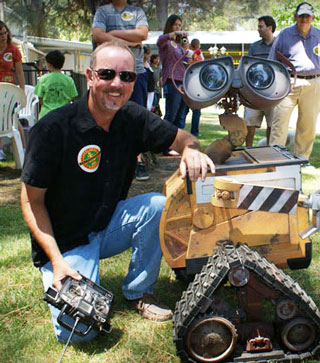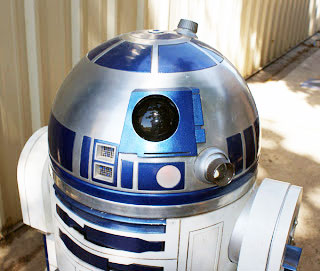
Robohub.org
Michael McMaster talks robots, building and his new project

If you’re a diehard Star Wars fan, or if you have a background in robotics, you might already know who Michael McMaster is. In the past, he’s partnered with Mike Senna to build two life-sized Wall-E replicas, and the little robots were featured on Tested.com. Now, McMaster has two more robots in his sights – an R4-P17 and R2-D2. He built an R2 unit ten years ago with the help of the Yahoo! Group: The R2 Builders’ Club, but he aims to best himself this time around.
I had the chance to sit down with McMaster and ask a few questions about his own personal experience, the droids and exactly how someone can build a droid for themselves.
AA: Hi, Mike. So, in terms of your background, what started all this robot building stuff? Do you have an education background in robotics?
MM: No robotics background, but I have been building things since I was a little boy. I used to make elaborate spaceships from cardboard and lumber, then slowly stepped up to go-carts and more practical things. I grew up on a citrus farm, so my Father designed much of our farm equipment, and I was tasked with building some of it myself. Through the R2 Builders group, I learned many new things. I had a little electronics experience from high school, but learned so much more in the first few years in the club. I was really excited to learn how to mold parts I had made, so I could reproduce them. I also learned how to properly paint and weather props through some very good teachers who are professional prop builders themselves.
So, you’ve done an R2D2 in the past. What makes the new R2D2 different than the old one? And what’s an R4-P17?
I built my first R2-D2 replica over ten years ago, during the early days of the R2 Builders Club, so it was slightly off-scale if a few places. The new robot will be as accurate as humanly possible and will also have most of the tools and gadgets you see him use in the original trilogy. He will be much more robust as well, utilizing the latest advances available today. The R4-P17 was seen in the newer Star Wars films, and was used by Obi-Wan on his Jedi Starfighter. What drew me to that character was the color scheme, as well as the fact that there were very few of them out there. It seems everyone has done an R2-D2 at this point!

How do you get accurate details on the R2 and R4 for the build? It sounds like it might be a tedious process.
I am fortunate to be involved with a diverse group of talented people in the R2 Builders Club. Many of them have already done a ton of research on the smallest details on each of the droids, which has helped by tremendously. Other than that information, I have used screen grabs from DVDs, and other printed sources. There are quite a few books on the making of Star Wars with some great behind the scenes photographs.
How will you control these fellas?
I use an RC switch relay and a few limit switches to make it all work. The timing is critical, so it takes some tweaking to get it just right. I will use [linear actuators] to move the center foot and out legs. Both droids will have the ability to transition from two leg to three leg mode. I typically use the PA-14s, as they fit in small spaces, are cost effective and very powerful!
If someone wants to be a part of the R2-D2 Builder’s Club, how do they do that?
You can visit the R2 Builders Club, which is a Yahoo group or visit Astromech.net. These groups offer an incredible resource, and the members are always willing to help and give advice. Anyone can build a droid!
I’m excited to see the build progress and will be watching closely to see how these two droids are brought to life. Good luck, Mike.
See also Mike McMaster’s robot holiday video.
tags: c-Arts-Entertainment, cx-Education-DIY, interview




